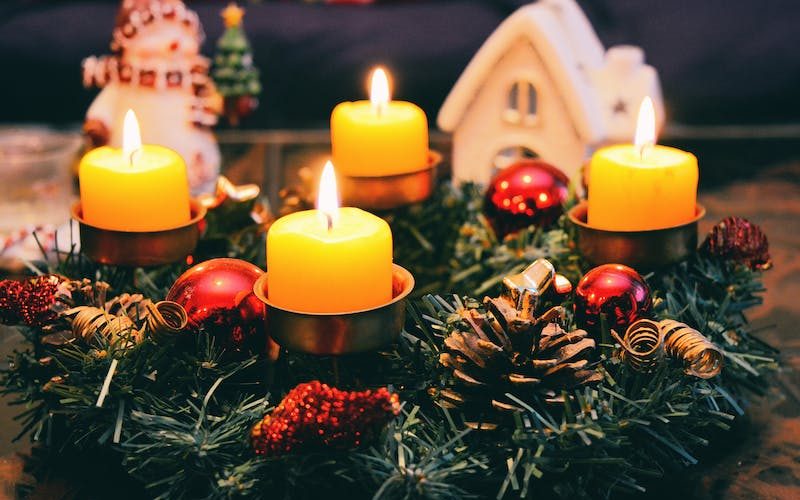Tradition is the cumulative experience of thousands of human lives. It is the conclusions reached by countless ancestors who tested what it meant to live well. Unfortunately, we are losing many of our traditions and their accompanying wisdom, abandoning the practices by which we speak to the past, and the past speaks to us.
One way our ancestors lived well was by engaging in certain yearly celebrations surrounding Christmas and the holiday season. They bequeathed many of these delightful and meaningful celebrations to us—if we care to receive them.
1. Victorian Crafts
Many of our Christmas traditions originate with the Victorians, including the decorating of a Christmas tree, which was first popularized by Prince Albert.
One decoration the Victorians used on their Christmas trees was the gilded walnut, a walnut shell adorned with gold foil or ribbon, sometimes with trinkets or prizes hidden inside. Another Victorian invention was the Christmas cracker. This device consists of a tube and wrapper that makes a snapping sound when opened. It contains some prize, usually used as a table decoration.
Another item you might find on the Victorian table was the orange pomander: an orange decorated with a ribbon or peeling patterns and pierced with cloves. And we can’t neglect the mistletoe. The use of greenery in Christmas decorations goes back to at least the Medieval era, and the Victorians were certainly using it in their day. In the 19th century, bunches of holly or other greenery with berries were made, and a gentleman could pluck a berry and give a lady a kiss on the cheek. Once the berries ran out, so did the kisses. In the Victorian era, these elaborate displays were reduced to smaller mistletoe balls.
Victorian Christmas crafts can be a fun activity for family nights or friend get-togethers; this video provides more history and a tutorial on how to create some festive Victorian décor.
2. Parlor Games
In addition to crafts, decorations, and feasts, the Victorians excelled at inventing parlor games to be played on long winter nights. These included some you may have heard of, like charades and blindman’s buff, and others you may not be familiar with, like pass the slipper, forfeits, and Reverend Carter. (This website offers a list of these games with instructions.)
Personal favorites of mine (that don’t, however, appear to originate from the Victorian era) include psychiatrist, a game a little like 20 questions but much more complex, and four on a couch, a dizzying, competitive memory game. Each of these games—Victorian-based or otherwise—can be a delightful bonding activity for long nights at home.
3. St. Nicholas’ Day
The modern figure of Santa Claus is based off the real-life Saint Nicholas, a fourth century bishop of Myra and patron saint of children. According to tradition, St. Nicholas was well-known for his kindness and generosity to the poor. He even left golden coins for some children by placing them in stockings that were hung up to dry. This, of course, is the origin of the modern custom of putting up stockings and leaving out milk and cookies for Santa.
St. Nicholas’ feast day is celebrated on December 6, during the lead-up to Christmas. “Saint Nick’s Day,” then, might actually be a more appropriate day for stocking stuffing than December 25. It would traditionally involve leaving chocolate coins, candy canes, and oranges in children’s shoes, stockings, or under their pillows. Certainly a delightful surprise for any youngster!
4. Caroling
I’m particularly partial to this one, as I have many memories of golden hours spent caroling at nursing homes or during Christmas parties throughout my adolescence. Caroling has always been a grand opportunity to bring cheer to people (such as the nursing home residents), while also spending quality time with friends and family. Nothing puts you more in the Christmas spirit than traditional carols.
5. Advent Wreaths
Advent is traditionally a period of penance in preparation for the coming of Christ on Christmas. Parties and celebrations didn’t typically take place during Advent; rather, the festivities used to occur on Christmas and during the following twelve days of celebration (cue “The Twelve Days of Christmas”).
To keep track of this preparatory season of Advent, many people used to keep an advent wreath in their homes. An advent wreath is a wreath with four candles, symbolizing the four weeks of Advent. Three of the candles are purple, a penitential liturgical color, and one is pink or rose, a color somewhere between the penitential purple and the celebratory white. Each week, a new candle is lit to mark the passage of the season. The rose candle is lit on Gaudete Sunday, the third Sunday of Advent, on which the liturgical color of rose is used to symbolize the joy of reaching the halfway mark of Advent.
Advent wreaths are a kind of breather in the midst of the penitential season, and for professing Christians, they can serve as a helpful reminder for the central meaning of Christmas: the birth of Jesus Christ.
6. St. Lucia’s Day
Another saint feast day, St. Lucy (or Lucia’s) day, originates in Scandinavia and takes place on December 13. Saint Lucy is the patron saint of the blind (lux or lucis means light in Latin), and her feast is meant to bring brightness to the dark days of winter.
To this end, each town or family would traditionally elect its own “St. Lucia,” a girl who would dress up as the saint for the day by wearing white and a headdress containing four candles. In a family, this was usually the eldest daughter, and once in her proper attire, she would serve coffee and baked goods (particularly saffron bread) to the other family members.
Here is a lovely and haunting video that reveals the magic of St. Lucia’s day, and here are some of the beautiful words from the “St. Lucy Song.”
Night walks with a heavy step
Round yard and house,
As the sun departs from earth,
Shadows are brooding.
Dreams of wings rustling over us in prophesy,
Light your white candles, Saint Lucia.Spells and dark powers, with light you subject.
Guard of the blessed flames, protection for us brings.
Dreams of wings rustling over us in prophesy,
Light your white candles, Saint Lucia.
Certainly, St. Lucia’s can be a delightful reminder of beauty within the Christmas season.
7. The Traveling Nativity Set
Most people are familiar with the tradition of a nativity set, but fewer people know about the traveling nativity set. In this tradition, the figures of Joseph and Mary (and perhaps a donkey) move a little bit closer to the stable each day, making the journey to the creche progressively over the course of Advent. Baby Jesus is not placed in the creche until Christmas morning, reminding the household of the power of Christmas.
So, these are seven holiday traditions worth reviving—they’re a delightful way to cheer hearth and home over the next month. The warmth of these traditions will seep into your bones, no matter how cold it may be outside and how bitterly the wind may howl.
—
Cadence McManimon also contributed to this article.
Image credit: Pexels


















